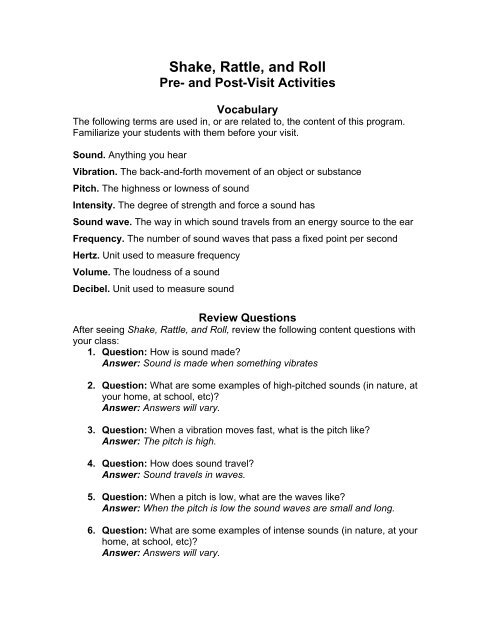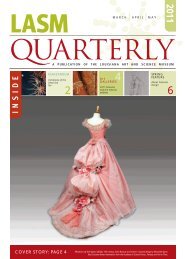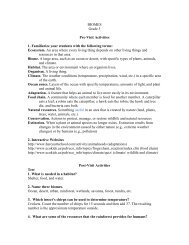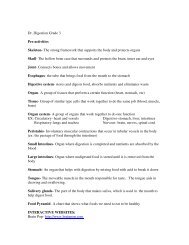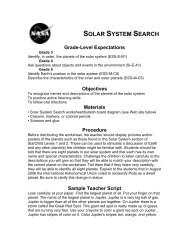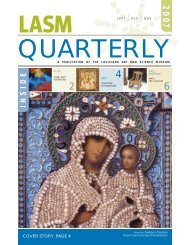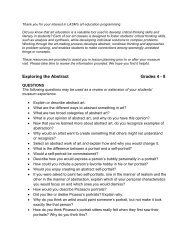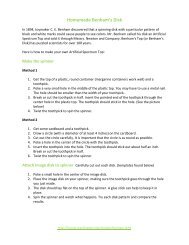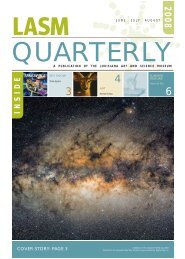Classroom Activities
Classroom Activities
Classroom Activities
Create successful ePaper yourself
Turn your PDF publications into a flip-book with our unique Google optimized e-Paper software.
Shake, Rattle, and Roll<br />
Pre- and Post-Visit <strong>Activities</strong><br />
Vocabulary<br />
The following terms are used in, or are related to, the content of this program.<br />
Familiarize your students with them before your visit.<br />
Sound. Anything you hear<br />
Vibration. The back-and-forth movement of an object or substance<br />
Pitch. The highness or lowness of sound<br />
Intensity. The degree of strength and force a sound has<br />
Sound wave. The way in which sound travels from an energy source to the ear<br />
Frequency. The number of sound waves that pass a fixed point per second<br />
Hertz. Unit used to measure frequency<br />
Volume. The loudness of a sound<br />
Decibel. Unit used to measure sound<br />
Review Questions<br />
After seeing Shake, Rattle, and Roll, review the following content questions with<br />
your class:<br />
1. Question: How is sound made?<br />
Answer: Sound is made when something vibrates<br />
2. Question: What are some examples of high-pitched sounds (in nature, at<br />
your home, at school, etc)?<br />
Answer: Answers will vary.<br />
3. Question: When a vibration moves fast, what is the pitch like?<br />
Answer: The pitch is high.<br />
4. Question: How does sound travel?<br />
Answer: Sound travels in waves.<br />
5. Question: When a pitch is low, what are the waves like?<br />
Answer: When the pitch is low the sound waves are small and long.<br />
6. Question: What are some examples of intense sounds (in nature, at your<br />
home, at school, etc)?<br />
Answer: Answers will vary.
Related Links and Experiments<br />
String Telephone<br />
http://pbskids.org/zoom/activities/sci/stringtelephone.html<br />
This hands-on experiment allows students to construct their own string<br />
telephones. Students can use the scientific method to predict what will happen<br />
when a variable (such as the cup size or cup material) is changed. Students can<br />
share their feedback and findings with other students around the U.S.<br />
Sound Waves in Stereo<br />
http://pbskids.org/zoom/activities/sci/stereohanger.html<br />
This hands-on experiment helps students to grasp the concept of sound waves<br />
and vibrations. Students can use the scientific method to predict what will happen<br />
when a variable is changed. Students can share their feedback and findings with<br />
other students around the U.S.<br />
American Sign Language<br />
Explain to students that there are many people that cannot hear sound. Ask them<br />
to imagine communicating without talking. Have students pair up and spell out a<br />
message or their names in sign language. Add a language-arts component by<br />
asking the students to write about what sound they would miss the most if they<br />
were deaf and why.<br />
With a parent’s permission, older students can visit the following Web site<br />
and watch video examples of ASL words: http://www.aslpro.com<br />
For extra credit ask students to “sign” a favorite nursery rhyme or short<br />
song.<br />
Do It Yourself Instruments!<br />
See the following Web site to find out how to start a band with your class<br />
using recycled materials:<br />
http://www.storytimesongs.com/instruments.html


